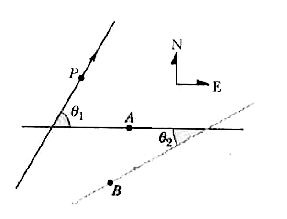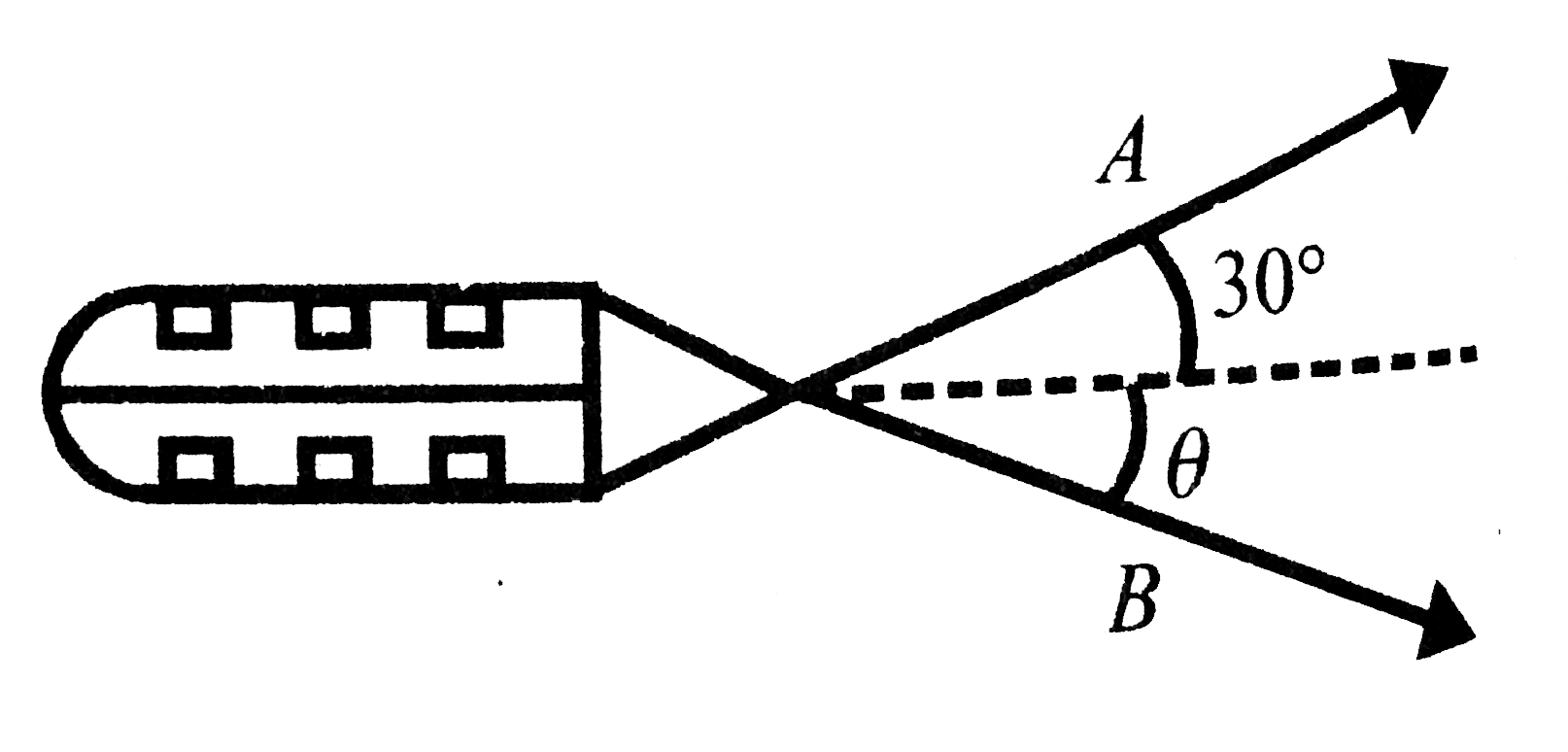In the distant future, a intergalactic ship leaves Earth orbit and accelerates to a constant speed of 0.92c. Determine the difference, , between the relativistic and classical momenta of the ship.
The correct Answer is:C
To determine the difference between the relativistic momentum p and the classical momentum p0 of the intergalactic ship, we will follow these steps:
Step 1: Calculate Classical Momentum p0
The classical momentum p0 is given by the formula:
p0=m0v
where:
- m0=5.4×105kg (rest mass of the ship)
- v=0.92c (velocity of the ship, where c is the speed of light)
Substituting the values:
p0=(5.4×105kg)×(0.92×c)
Using c≈3×108m/s:
p0=(5.4×105)×(0.92×3×108)
Calculating this gives:
p0=(5.4×105)×(2.76×108)=1.4904×1014kg m/s
Step 2: Calculate Relativistic Momentum p
The relativistic momentum p is given by the formula:
p=m0v√1−v2c2
First, we need to calculate √1−v2c2:
v2c2=(0.92)2=0.8464
Thus,
1−v2c2=1−0.8464=0.1536
Now, taking the square root:
√1−v2c2=√0.1536≈0.39
Now substituting this back into the relativistic momentum formula:
p=(5.4×105)×(0.92×c)√0.1536=(5.4×105)×(2.76×108)0.39
Calculating this gives:
p≈1.4904×10140.39≈3.8205×1014kg m/s
Step 3: Calculate the Difference p−p0
Now we can find the difference between the relativistic momentum and the classical momentum:
p−p0=3.8205×1014−1.4904×1014
Calculating this gives:
p−p0≈2.3301×1014kg m/s
Final Answer
The difference between the relativistic and classical momenta of the ship is approximately:
2.33×1014kg m/s
The classical momentum p0 is given by the formula:
p0=m0v
where:
- m0=5.4×105kg (rest mass of the ship)
- v=0.92c (velocity of the ship, where c is the speed of light)
p0=(5.4×105kg)×(0.92×c)
Using c≈3×108m/s:
p0=(5.4×105)×(0.92×3×108)
Calculating this gives:
p0=(5.4×105)×(2.76×108)=1.4904×1014kg m/s
The relativistic momentum p is given by the formula:
p=m0v√1−v2c2
First, we need to calculate √1−v2c2:
v2c2=(0.92)2=0.8464
Thus,
1−v2c2=1−0.8464=0.1536
Now, taking the square root:
√1−v2c2=√0.1536≈0.39
Now substituting this back into the relativistic momentum formula:
p=(5.4×105)×(0.92×c)√0.1536=(5.4×105)×(2.76×108)0.39
Calculating this gives:
p≈1.4904×10140.39≈3.8205×1014kg m/s
Now we can find the difference between the relativistic momentum and the classical momentum:
p−p0=3.8205×1014−1.4904×1014
Calculating this gives:
p−p0≈2.3301×1014kg m/s
The difference between the relativistic and classical momenta of the ship is approximately:
2.33×1014kg m/s
Topper's Solved these Questions
- RELATIVITYBOOK - RESNICK AND HALLIDAYCHAPTER - RELATIVITYEXERCISE - PRACTICE QUESTIONS (Linked Comprehension)
11 Videos
- RELATIVITYBOOK - RESNICK AND HALLIDAYCHAPTER - RELATIVITYEXERCISE - PRACTICE QUESTIONS (Integer Type)
5 Videos
- RELATIVITYBOOK - RESNICK AND HALLIDAYCHAPTER - RELATIVITYEXERCISE - PROBLEMS
49 Videos
- PHOTONS AND MATTER WAVESBOOK - RESNICK AND HALLIDAYCHAPTER - PHOTONS AND MATTER WAVESEXERCISE - PRACTICE QUESTIONS(Integer Type)
4 Videos
- RIGID BODY DYNAMICS - IBOOK - RESNICK AND HALLIDAYCHAPTER - RIGID BODY DYNAMICS - IEXERCISE - PRACTICE QUESTIONS (INTEGER TYPE))
3 Videos
Similar Questions
An electron moves in a circular orbit of radius 10 cm with a constant speed of 4.0×106ms−1. Determine the electric current at a point on the orbit.
View SolutionIn the overhead view of Fig. 4-40, Jeeps P and B race along straight lines, across flat terrain, and past stationary border guard A. Relative to the guard, B travels at a constant speed of 25.0 m/s, at the angle θ2=30.0∘. Relative to the guard, P has accelerated from rest at a constant rate of 0.400m/s2 at the angle θ1=60.0∘. At a certain time during the acceleration, P has a speed of 40.0 m/s. At that time, what are the (a) magnitude and (b) direction of the velocity of P relative to B and the ( c) magnitude and (d) direction of the acceleration of P relative to B?

View Solution
Knowledge Check
A proton has a mass of 1.673×10−27kg. If the proton is accelerated to a speed of 0.93c , what is the magnitude of the relativistic momentum of the proton?
A6.2×10−17kg⋅m/sB4.7×10−19kg⋅m/sC1.3×10−18kg⋅m/sD5.9×10−24kg⋅m/sIf the distance between the points (4,p) and (1,0) is 5 , then find the value of p.
A4 onlyB±4C−4onlyD0A small object, which has a charge q=7.5μC and mass m=9.0×10−5kg, is placed in a constant electric field. Starting from rest, the object accelerates to a speed of 2.0×103m/s in a time of 0.96 s. Determine the magnitude of the electric field.
A2.5×104N/CB4.5×104N/CC3.4×104N/CD1.7×104N/C
There is no difference between 0.005 or 5.00×10−3 g.
View SolutionAn Earth starship has been sent to check an Earth outpost on the planet P1407, whose moon houses a battle group of the often hostile Reptulians. As the ship follows a straightline course first past the planet and then past the moon, it detects a high-energy microwave burst at the Reptulian moon base and then, 1.10 s later, an explosion at the Earth outpost, which is 4.00×108 m from the Reptulian base as measured from the ship's reference frame. The Reptulians have obviously attacked the Earth outpost, and so the starship begins to prepare for a confrontation with them.
The speed of the ship relative to the planet and its moon is 0.980c. What are the distance and time interval between the burst and the explosion as measured in the planet-moon frame (and thus according to the occupants of the stations)?
View SolutionTwo particles each have a mass of 6.0×10−3 kg. One has a charge of +5.0×10−6 C. and the other has a charge of −5.0×10−6 C. They are initially held at rest at a distance of 0.80 m apart. Both are then released and accelerate toward each other. How fast is each particle moving when the separation between them is one-third its initial value?
View SolutionA ship of mass 3×107 kg initially at rest is pulled by a force of 5×104 N through a distance of 3 m. Assuming that the resistance due to water is negligible, what will be the speed of the ship?
View SolutionTwo ropes are puling a large ship at rest of mass 1×106kg into harbour. Rope A exerts a force of 40,000N and rope B exerts a force of 30,000N.

If the acceleration of the ship is 0.03ms−2, the magnitude of the resistive forces on the ship is
View Solution
